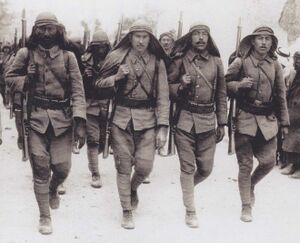Western Theater (Siduri War)
The Western Theater was a theater of conflict between the Inner Sphere and the Common Axis during the Siduri War, pitting the Republic of Syara and the Shirvani Dominion, against Mansuriyyah, the Cacertian Empire, and Ruvelkan forces in exile. The theater was the largest of the three main fronts during the war, with engagements all along Western Siduri and naval operations extending into the Sabri Sea and Nuadan Ocean. The combination of extensive land and sea campaigns, coupled with the back and forth nature of the fighting across varied terrain contributed to unique military historiography of the theater; among general historians it is known interchangeably as the Western Theater or the Mansuri Front. The Syarans considered it an extension of the Southern Front along with the Tennaiite Front, while the Cacertians considered it the West Siduri Front.
Mansuriyyah's poor strategic position, courtesy of being surrounded by the Inner Sphere (Syaran occupied Ruvelka in the north, the Dominion to the east) and neutral nations, initially left it a low priority target for the Inner Sphere. A cursory invasion force of the Army of the Syaran Republic was launched in October of 1934 aming to drive down the Mansuri coast, but limited progress was made and the offensive was called off in the spring of 1935. In the summer the Dominion launched it's own invasion of eastern Mansuriyyah, resulting in pitched battles across the Mansuri desert. Recognizing the strategic possibilities, the Cacertian Empire began planning to stage naval and air forces out of Mansuriyyah to attack Syara proper. After months of intermittent skirmishing the Syaran National Fleet clashed with the Cacertian Imperial Navy in the Battle of the Sabri Sea, ending with a decisive Cacertian victory. Sensing the potential danger, the Inner Sphere launched a renewed offensive in the spring of 1936, but the effort was halted after the disatorous defeat in Operation Kunai Grass shortages of resources forced the IS to call off it's attack. Subsequent Mansuri counter-offensives drove the Inner Sphere back on all fronts, though the Mansuri were unable to surmount Syaran defenses along the Matra Mountains. The Mansuri spent the remainder of 1936 and early 1937 driving Dominion forces from eastern Mansuriyyah, succeeded in March 1937. The collapse of the Shirvani war effort in May ended the Dominion threat, allowing the Mansuri armed forces to reorient against Syaran-occupied Ruvelka. Mansuri forces launched several diversionary offensives during the Liberation of Ruvelka in late 1937, remaining on the attack until the end of the war in 1938.
Due to the combined land and sea campaigns, the Western Theater has often been considered in a realm of it's own apart from the other theaters of the war. Unlike the colossal engagements of the Quenminese Front or the arduous mountain warfare of the Tennaiite Front, the Mansuri Front remained a very fluid battlefield, with both sides frequently gaining or losing large tracts of land. Defensive operations were made difficult to the relative openness and highly centralized urban areas, resulting in the frontline ebbing and flowing with each major offensive. The lack of attrition-based campaigns or high concentration of forces meant that the Western Theater was the least bloody of the three main theaters, although losses still amounted to nearly 3 million killed and over 6 million wounded.
